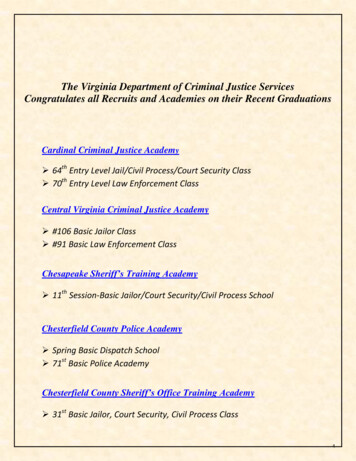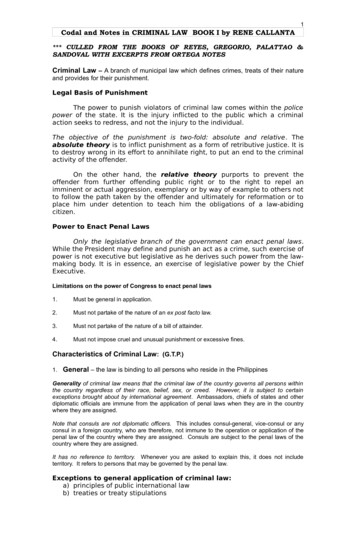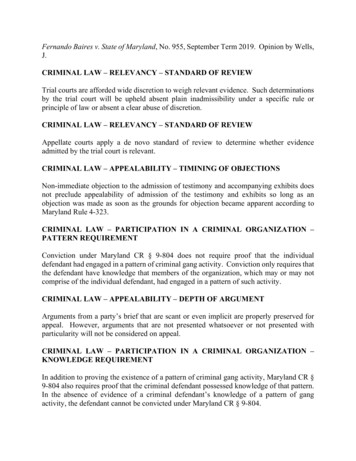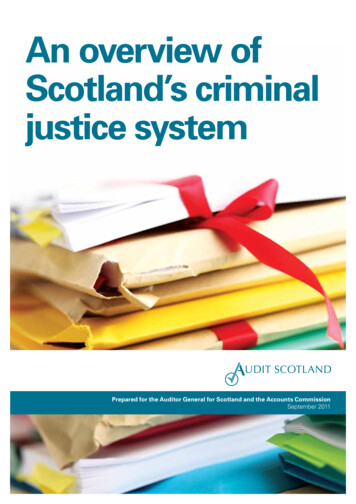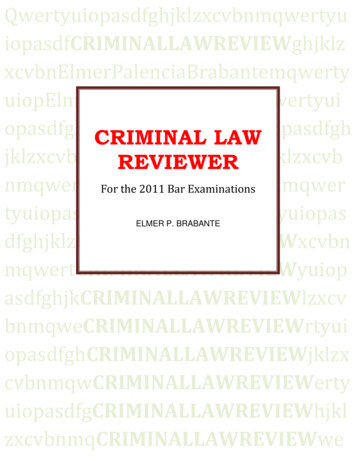
Transcription
This text was adapted by The Saylor Foundation under a CreativeCommons Attribution-NonCommercial-ShareAlike 3.0 License withoutattribution as requested by the work’s original creator or licensee.Saylor URL: http://www.saylor.org/booksSaylor.org1
PrefaceWelcome to Criminal Law, your guide to a fascinating yet challenging topic. This engaging and interactivetextbook will enhance your ability to be successful in academics or a career in criminal justice.ContentCriminal Law begins with the foundations of law and the legal system and then extensively explorescriminal laws and defenses using general state principles, federal law, the Constitution, and the ModelPenal Code as guidelines. Although it is neither possible nor desirable to discuss every criminal law, thistextbook provides a basic yet thorough overview of the American criminal justice system. Aftercompleting Criminal Law, you will be familiar with the nature and sources of law, the court system, theadversarial process, the most prominent crimes, and accompanying criminal defenses.ApproachCriminal Law uses a two-step process to augment learning, called the appliedapproach. First, afterbuilding a strong foundation from scratch, Criminal Lawintroduces you to crimes and defenses that havebeen broken down into separate components. It is so much easier to memorize and comprehend thesubject matter when it is simplified this way. However, becoming proficient in the law takes more thanjust memorization. You must be trained to take the laws you have studied and apply them to various factpatterns. Most students are expected to do this automatically, but application must be seen, experienced,and practiced before it comes naturally. Thus the second step of the applied approach is reviewingexamples of the application of law to facts after dissecting and analyzing each legal concept. Some of theexamples come from cases, and some are purely fictional. All the examples are memorable, even quirky,so they will stick in your mind and be available when you need them the most (like during an exam). Aftera few chapters, you will notice that you no longer obsess over an explanation that doesn’t completely makesense the first time you read it—you will just skip to the example. The examples clarify the principles foryou, lightening the workload significantly.Saylor URL: http://www.saylor.org/booksSaylor.org2
FeaturesLet’s face it, legal textbooks can be dry. This is unfortunate because law, especially criminal law, is anintrinsically compelling topic. To hold your attention and keep you alert, Criminal Law employs a varietyof instructional techniques that should engage you from start to finish.First, chapters contain embedded videos, ethical scenarios, charts, diagrams, and tables to demonstratethe legal concepts and examples provided. These enhancements break up the text and also appeal tovarious learning styles.In addition, instead of wasting valuable textbook space by reprinting edited cases,Criminal Law links tocases online. You can read more cases that way, and cases are like examples—they demonstrate theapplication of law to facts. Also, you can read the entire case exactly the way the judge wrote it, instead ofan edited version that has been shrunk to fit into a limited amount of pages.Have you ever tried to check your answers to review questions in a textbook, only to find that the correctanswers are nowhere in sight? Criminal Law gives you the answer to every question at the end of eachchapter. Go ahead and check the answers first. Contrary to popular belief, this actually improves—anddoes not detract from—learning.In addition, Criminal Law includes hundreds of footnotes that link to online cases and statutes;supplementary links to articles, websites, and statistics online; and plenty of reference material for a termpaper or other research project. In short, Criminal Lawshould contain everything you need to successfullycomplete your course. It is also a valuable guide to which you can refer throughout your criminal justicecareer.GoalsAlthough academic success is important, I wrote Criminal Law to increase your awareness as you readthe newspaper (or read the news online), watch television, or discuss legal situations with friends andcolleagues. Law is an integral part of life, yet most people lack the most fundamental understanding oflegal concepts. My sincere hope is that once you have finished reading Criminal Law, you will becomeyour own most trusted legal authority.Chapter 1Introduction to Criminal LawSaylor URL: http://www.saylor.org/booksSaylor.org3
Elementary notions of fairness enshrined in our constitutional jurisprudence dictate that a personreceive fair notice not only of the conduct that will subject him to punishment but also of the severity ofthe penalty that a State may impose.BMW of North America, Inc. v. Gore, cited in Section 1 "Damages"1.1 IntroductionLEARNING OBJECTIVE1.Define a crime.This textbook introduces you to our legal system in the United States, the basic elements of a crime, the specificelements of commonly encountered crimes, and most criminal defenses. Criminal law always involves thegovernment and government action, so you will also review the pertinent sections of the United States Constitutionand its principles as they apply to criminal law. By the end of the book, you will be comfortable with the legalframework that governs the careers of criminal justice professionals.Definition of a CrimeLet’s begin at the beginning by defining a crime. The most basic definition of a crime is “an act committedin violation of a law prohibiting it, or omitted in violation of a law ordering it.”[1]You learn about criminalact and omission to act in Chapter 4 "The Elements of a Crime". For now, it is important to understandthat criminal act, omission to act, and criminal intent are elements or parts of every crime. Illegality isalso an element of every crime. Generally, the government must enact a criminal lawspecifying a crimeand its elements before it can punish an individual for criminal behavior. Criminal laws are the primaryfocus of this book. As you slowly start to build your knowledge and understanding of criminal law, you willnotice some unique characteristics of the United States’ legal system.Laws differ significantly from state to state. Throughout the United States, each state and the federalgovernment criminalize different behaviors. Although this plethora of laws makes American legal studiesmore complicated for teachers and students, the size, cultural makeup, and geographic variety of ourcountry demand this type of legal system.Laws in a democratic society, unlike laws of nature, are created by people and are founded in religious,cultural, and historical value systems. People from varying backgrounds live in different regions of thiscountry. Thus you will see that different people enact distinct laws that best suit their needs. This book isSaylor URL: http://www.saylor.org/booksSaylor.org4
intended for use in all states. However, the bulk of any criminal law overview is an examination ofdifferent crimes and their elements. To be accurate and representative, this book focusesongeneral principles that many states follow and provides frequent references to specific state laws forillustrative purposes. Always check the most current version of your state’s law because it may vary fromthe law presented in this book.Laws are not static. As society changes, so do the laws that govern behavior. Evolving value systemsnaturally lead to new laws and regulations supporting modern beliefs. Although a certain stability isessential to the enforcement of rules, occasionally the rules must change.Try to maintain an open mind when reviewing the different and often contradictory laws set forth in thisbook. Law is not exact, like science or math. Also try to become comfortable with the gray area, ratherthan viewing situations as black or white.KEY TAKEAWAY A crime is an act committed in violation of a law prohibiting it or omitted in violation of alaw ordering it. In general, the criminal law must be enacted before the crime iscommitted.EXERCISEAnswer the following question. Check your answer using the answer key at the end of the chapter.1. Read Gonzales v. Oregon, 546 U.S. 243 (2006). Did the US Supreme Court preserveOregon’s right to legalize physician-assisted suicide? The case is available at thislink: ml.1.2 Criminal Law and Criminal ProcedureLEARNING OBJECTIVE1.Compare criminal law and criminal procedure.Saylor URL: http://www.saylor.org/booksSaylor.org5
This book focuses on criminal law, but it occasionally touches on issues ofcriminal procedure, so it is important todifferentiate between the two.Criminal law generally defines the rights and obligations of individuals in society. Some common issues in criminallaw are the elements of specific crimes and the elements of various criminal defenses. Criminal procedure generallyconcerns theenforcement of individuals’ rights during the criminal process. Examples of procedural issues areindividuals’ rights during law enforcement investigation, arrest, filing of charges, trial, and appeal.Example of Criminal Law IssuesClara and Linda go on a shopping spree. Linda insists that they browse an expensive department store.Moments after they enter the lingerie department, Linda surreptitiously places a bra in her purse. Clarawatches, horrified, but does not say anything, even though a security guard is standing nearby. Thisexample illustrates two issues of criminal law: (1) Which crime did Linda commit when she shoplifted thebra? (2) Did Clara commit a crime when she failed to alert the security guard to Linda’s shoplifting? Youlearn the answer to issue (1) in Chapter 11 "Crimes against Property"and issue (2) in Chapter 4 "TheElements of a Crime" and Chapter 7 "Parties to Crime".Example of Criminal Procedure IssuesReview the example in Section 1.2.1 "Example of Criminal Law Issues". Assume that Linda and Claraattempt to leave the store and an alarm is activated. Linda begins sprinting down the street. Colin, a policeofficer, just happens to be driving by with the window of his patrol car open. He hears the store alarm,sees Linda running, and begins shooting at Linda from the car. Linda is shot in the leg and collapses.Linda is treated at the hospital for her injury, and when she is released, Colin arrests her and transportsher to the police station. He brings her to an isolated room and leaves her there alone. Twelve hours later,he reenters the room and begins questioning Linda. Linda immediately requests an attorney. Colinignores this request and continues to question Linda about the reason the department store alarm wentoff. Whether Colin properly arrested and interrogated Linda are criminal procedure issues beyond thescope of this book. However, this example does illustrate one criminal law issue: did Colin commit acrime when he shot Linda in the leg? You learn the answer to this question in Chapter 5 "CriminalDefenses, Part 1".Figure 1.1 Criminal Law and Criminal ProcedureSaylor URL: http://www.saylor.org/booksSaylor.org6
KEY TAKEAWAY Criminal law generally defines the rights and obligations of individuals in society.Criminal procedure generally concerns the enforcement of individuals’ rights during thecriminal process.EXERCISESAnswer the following questions. Check your answers using the answer key at the end of the chapter.1. Paul, a law enforcement officer, arrests Barney for creating a disturbance at a subwaystation. While Barney is handcuffed facedown on the ground, Paul shoots and kills him.Paul claims that he accidentally grabbed his gun instead of his Taser. Is this an issue ofcriminal law or criminal procedure?2. Read Payton v. New York, 445 U.S. 573 (1980). In Payton, the US Supreme Court held aNew York statute unconstitutional under the Fourth Amendment. Did thePayton rulingfocus on criminal law or criminal procedure? The case is available at thislink: http://supreme.justia.com/us/445/573.1.3 The Difference between Civil and Criminal LawLEARNING OBJECTIVESSaylor URL: http://www.saylor.org/booksSaylor.org7
1.Compare civil and criminal law.2. Ascertain the primary differences between civil litigation and a criminal prosecution.Law can be classified in a variety of ways. One of the most general classifications divides law into civil andcriminal. A basic definition of civil law is “the body of law having to do with the private rights ofindividuals.”[1]As this definition indicates, civil law is between individuals, not the government. Criminallaw involves regulations enacted and enforced by government action, while civil law provides a remedy forindividuals who need to enforce private rights against other individuals. Some examples of civil law arefamily law, wills and trusts, and contract law. If individuals need to resolve a civil dispute, this iscalled civil litigation, or a civil lawsuit. When the type of civil litigation involves an injury, the injury actionis called a tort.Characteristics of Civil LitigationIt is important to distinguish between civil litigation and criminal prosecution. Civil and criminal casesshare the same courts, but they have very different goals, purposes, and results. Sometimes, one set offacts gives way to a civil lawsuit and a criminal prosecution. This does not violate double jeopardy and isactually quite common.Parties in Civil LitigationIn civil litigation, an injured party sues to receive a court-ordered remedy, such as money, property, orsome sort of performance. Anyone who is injured—an individual, corporation, or other business entity—can sue civilly. In a civil litigation matter, the injured party that is suing is called the plaintiff. A plaintiffmust hire and pay for an attorney or represent himself or herself. Hiring an attorney is one of the manycosts of litigation and should be carefully contemplated before jumping into a lawsuit.The alleged wrongdoer and the person or entity being sued are called the defendant. While theterm plaintiff is always associated with civil litigation, the wrongdoer is called a defendant in both civillitigation and a criminal prosecution, so this can be confusing. The defendant can be any person or thingthat has caused harm, including an individual, corporation, or other business entity. A defendant in a civillitigation matter must hire and pay for an attorney even if that defendant did nothing wrong. The right toa free attorney does not apply in civil litigation, so a defendant who cannot afford an attorney mustrepresent himself or herself.Saylor URL: http://www.saylor.org/booksSaylor.org8
Goal of Civil LitigationThe goal of civil litigation is to compensate the plaintiff for any injuries and to put the plaintiff back in theposition that person held before the injury occurred. This goal produces interesting results. It occasionallycreates liability or an obligation to pay when there is no fault on behalf of the defendant. The goal is tomake the plaintiff whole, not to punish, so fault is not really an issue. If the defendant has the resources topay, sometimes the law requires the defendant to pay so that society does not bear the cost of theplaintiff’s injury.A defendant may be liable without fault in two situations. First, the law that the defendant violated maynot require fault. Usually, this is referred to as strict liability. Strict liability torts do not require faultbecause they do not include an intent component. Strict liability and other intent issues are discussed indetail in Chapter 4 "The Elements of a Crime". Another situation where the defendant may be liablewithout fault is if the defendant did not actually commit any act but is associated with the actingdefendant through a special relationship. The policy of holding a separate entity or individual liable forthe defendant’s action is called vicarious liability. An example of vicarious liability is employer-employeeliability, also referred to asrespondeat superior. If an employee injures a plaintiff while on the job,theemployer may be liable for the plaintiff’s injuries, whether or not the employer is at fault. Clearly,between the employer and the employee, the employer generally has the better ability to pay.Example of Respondeat SuperiorChris begins the first day at his new job as a cashier at a local McDonald’s restaurant. Chris attempts tomultitask and pour hot coffee while simultaneously handing out change. He loses his grip on the coffeepot and spills steaming-hot coffee on his customer Geoff’s hand. In this case, Geoff can sue McDonald’sand Chris if he sustains injuries. McDonald’s is not technically at fault, but it may be liable for Geoff’sinjuries under a theory of respondeat superior.Harm RequirementThe goal of civil litigation is to compensate the plaintiff for injuries, so the plaintiff must be a bonafide victim that can prove harm. If there is no evidence of harm, the plaintiff has no basis for the civillitigation matter. An example would be when a defendant rear-ends a plaintiff in an automobile accidentwithout causing damage to the vehicle (property damage) or physical injury. Even if the defendant is atSaylor URL: http://www.saylor.org/booksSaylor.org9
fault for the automobile accident, the plaintiff cannot sue because the plaintiff does not needcompensation for any injuries or losses.DamagesOften the plaintiff sues the defendant for money rather than a different, performance-oriented remedy. Ina civil litigation matter, any money the court awards to the plaintiff is called damages. Several kinds ofdamages may be appropriate. The plaintiff can sue for compensatory damages, which compensate forinjuries, costs, which repay the lawsuit expenses, and in some cases, punitive damages. Punitive damages,also referred to as exemplary damages, are not designed to compensate the plaintiff but instead focuson punishing the defendant for causing the injury.[2]Characteristics of a Criminal ProsecutionA criminal prosecution takes place after a defendant violates a federal or state criminal statute, or in somejurisdictions, after a defendant commits a common-law crime. Statutes and common-law crimes arediscussed in Section 1.6 "Sources of Law".Parties in a Criminal ProsecutionThe government institutes the criminal prosecution, rather than an individual plaintiff. If the defendantcommits a federal crime, the United States of America pursues the criminal prosecution. If thedefendant commits a state crime, the state government, often called the People of the State pursues thecriminal prosecution. As in a civil lawsuit, the alleged wrongdoer is called the defendant and can be anindividual, corporation, or other business entity.The attorney who represents the government controls the criminal prosecution. In a federal criminalprosecution, this is the United States Attorney.[3]In a state criminal prosecution, this is generally[4]a state prosecutor or a district attorney. A state prosecutor works for the state but is typically anelected official who represents the county where the defendant allegedly committed the crime.Applicability of the Constitution in a Criminal ProsecutionThe defendant in a criminal prosecution can be represented by a private attorney or afree attorney paidfor by the state or federal government if he or she is unable to afford attorney’s fees and facingincarceration.[5]Attorneys provided by the government are called public defenders.[6]This is a significantdifference from a civil litigation matter, where both the plaintiff and the defendant must hire and pay fortheir own private attorneys. The court appoints a free attorney to represent the defendant in a criminalSaylor URL: http://www.saylor.org/booksSaylor.org10
prosecution because the Constitution is in effect in any criminal proceeding. The Constitution provides forthe assistance of counsel in the Sixth Amendment, soevery criminal defendant facing incarceration hasthe right to legal representation, regardless of wealth.The presence of the Constitution at every phase of a criminal prosecution changes the proceedingssignificantly from the civil lawsuit. The criminal defendant receives many constitutional protections,including the right to remain silent, the right to due process of law, the freedom from double jeopardy,and the right to a jury trial, among others.Goal of a Criminal ProsecutionAnother substantial difference between civil litigation and criminal prosecution is thegoal. Recall that thegoal of civil litigation is to compensate the plaintiff for injuries. In contrast, the goal of a criminalprosecution is to punish the defendant.One consequence of the goal of punishment in a criminal prosecution is that fault is almost always anelement in any criminal proceeding. This is unlike civil litigation, where the ability to pay is a priorityconsideration. Clearly, it is unfair to punish a defendant who did nothing wrong. This makes criminal lawjustice oriented and very satisfying for most students.Injury and a victim are not necessary components of a criminal prosecution because punishment is theobjective, and there is no plaintiff. Thus behavior can be criminal even if it is essentially harmless. Societydoes not condone or pardon conduct simply because it fails to produce a tangible loss.Examples of Victimless and Harmless CrimesSteven is angry because his friend Bob broke his skateboard. Steven gets his gun, which has a silencer onit, and puts it in the glove compartment of his car. He then begins driving to Bob’s house. While Steven isdriving, he exceeds the speed limit on three different occasions. Steven arrives at Bob’s house and then hehides in the bushes by the mailbox and waits. After an hour, Bob opens the front door and walks to themailbox. Bob gets his mail, turns around, and begins walking back to the house. Steven shoots at Bobthree different times but misses, and the bullets end up landing in the dirt. Bob does not notice the shotsbecause of the silencer.In this example, Steven has committed several crimes: (1) If Steven does not have a special permit to carrya concealed weapon, putting the gun in his glove compartment is probably a crime in most states. (2) IfSteven does not have a special permit to own a silencer for his gun, this is probably a crime in most states.Saylor URL: http://www.saylor.org/booksSaylor.org11
(3) If Steven does not put the gun in a locked container when he transports it, this is probably a crime inmost states. (4) Steven committed a crime each time he exceeded the speed limit. (5) Each time Stevenshot at Bob and missed, he probably committed the crime of attempted murder or assault with a deadlyweapon in most states. Notice that none of the crimes Steven committed caused any discernible harm.However, common sense dictates that Steven should be punished so he does not commit a criminal act inthe future that mayresult in harm.Table 1.1 Comparison of Criminal Prosecution and Civil LitigationFeatureCriminal ProsecutionCivil LitigationVictimNoYes. This is the plaintiff.HarmNoYes. This is the basis for damages.Initiator of lawsuitFederal or state governmentPlaintiffAttorney for the initiatorUS Attorney or state prosecutorPrivate attorneyAttorney for the defendant Private attorney or public defender Private attorneyConstitutional protections YesSaylor URL: http://www.saylor.org/booksNoSaylor.org12
Figure 1.2 Crack the CodeLAW AND ETHICS: THE O. J. SIMPSON CASETwo Different Trials—Two Different ResultsO. J. Simpson was prosecuted criminally and sued civilly for the murder and wrongful death of victims Ron Goldmanand his ex-wife, Nicole Brown Simpson. In the criminal prosecution, which came first, the US Constitution provided O.J. Simpson with the right to a fair trial (due process) and the right to remain silent (privilege against self-incrimination).Saylor URL: http://www.saylor.org/booksSaylor.org13
Thus the burden of proof was beyond a reasonable doubt, and O. J. Simpson did not have to testify. O. J. Simpson wasacquitted, or found not guilty, in the criminal trial.[7]In the subsequent civil lawsuit, the burden of proof was preponderance of evidence, which is 51–49 percent, and O. J.Simpson was forced to testify. O. J. Simpson was found liable in the civil lawsuit. The jury awarded 8.5 million incompensatory damages to Fred Goldman (Ron Goldman’s father) and his ex-wife Sharon Rufo. A few days later, thejury awarded punitive damages of 25 million to be shared between Nicole Brown Simpson’s children and FredGoldman.1.[8]Do you think it is ethical to give criminal defendants more legal protection than civildefendants? Why or why not?2. Why do you think the criminal trial of O. J. Simpson took place before the civil trial?Check your answers to both questions using the answer key at the end of the chapter.KEY TAKEAWAYS Civil law regulates the private rights of individuals. Criminal law regulates individuals’conduct to protect the public. Civil litigation is a legal action between individuals to resolve a civil dispute. Criminalprosecution is when the government prosecutes a defendant to punish illegal conduct.EXERCISESAnswer the following questions. Check your answers using the answer key at the end of the chapter.1. Jerry, a law enforcement officer, pulls Juanita over for speeding. When Jerry beginswriting Juanita’s traffic ticket, she starts to berate him and accuse him of racial profiling.Jerry surreptitiously reaches into his pocket and activates a tape recorder. Juanita latercalls the highway patrol where Jerry works and files a false complaint against Jerry. Jerrysues Juanita for 500 in small claims court for filing the false report. He uses the taperecording as evidence. Is this a civil litigation matter or a criminal prosecution?2. Read Johnson v. Pearce, 148 N.C.App. 199 (2001). In this case, the plaintiff sued thedefendant for criminal conversation. Is this a civil litigation matter or a criminalprosecution? The case is available at thislink:http://scholar.google.com/scholar case?case 10159013992593966605&q Johnson v. Pearce&hl en&as sdt 2,5.Saylor URL: http://www.saylor.org/booksSaylor.org14
[1] Yourdictionary.com, “Definition of Civil Law,” accessed August 16, 2010,http://www.yourdictionary.com/civillaw.[2] BMW of North America, Inc. v. Gore, 517 U.S. 559 (1996), accessed February 96.ZO.html.[3] United States Department of Justice, “United States Attorneys,” accessed February 15,2010, http://www.justice.gov/usao.[4] “United States’ Prosecuting Attorneys,” Galaxy.com website, accessed February 15,2010,http://www.galaxy.com/dir968533/United States.htm.[5] Alabama v. Shelton, 535 U.S. 654 (2002), accessed August 16, ZO.html.[6] 18 U.S.C. § 3006A, accessed February 15, ml.[7] Doug Linder, “The Trial of Orenthal James Simpson,” UMKC website, accessed August 18,2010, impson/Simpsonaccount.htm.[8] Thomas L. Jones, “Justice for the Dead,” TruTV website, accessed August us murders/famous/simpson/dead 16.html.1.4 Classification of CrimesLEARNING OBJECTIVES1.Ascertain the basis for grading.2. Compare malum in se and malum prohibitum crimes.3. Compare the punishment options for felonies, misdemeanors, felony-misdemeanors,and infractions.4. Compare jail and prison.Crimes can be classified in many ways. Crimes also can be grouped by subject matter. For example, acrime like assault, battery, or rape tends to injure another person’s body, so it can be classified as a “crimeagainst the person.” If a crime tends to injure a person by depriving him or her of property or bydamaging property, it can be classified as a “crime against property.” These classifications are basically forconvenience and are not imperative to the study of criminal law.Saylor URL: http://www.saylor.org/booksSaylor.org15
More important and substantive is the classification of crimes according to the severity of punishment.This is called grading. Crimes are generally graded into four categories: felonies, misdemeanors, felonymisdemeanors, and infractions. Often the criminal intent element affects a crime’sgrading. Malum in se crimes, murder, for example, are evil in their nature and are generally graded higherthanmalum prohibitum crimes, which are regulatory, like a failure to pay income taxes.FeloniesFelonies are the most serious crimes. They are either supported by a heinous intent, like the intent tokill, or accompanied by an extremely serious result, such as loss of life, grievous injury, or destruction ofproperty. Felonies are serious, so they are graded the highest, and all sentencing options are available.Depending on the jurisdiction and the crime, the sentence could be execution, prison time, a fine, oralternative sentencing such as probation, rehabilitation, and home confinement. Potential consequencesof a felony conviction also include the inability to vote, own a weapon, or even participate in certaincareers.MisdemeanorsMisdemeanors are less serious than felonies, either because the intent requirement is of a lower level orbecause the result is less extreme. Misdemeanors are usually punishable by jail time of one year or lessper misdemeanor, a fine, or alternative sentencing like probation, rehabilitation, or community service.Note that incarceration for a misdemeanor is in jail rather than prison. The difference between jail andprison is that cities and counties operate jails, and the state or federal government operates prisons,depending on the crime. The restrictive nature of the confinement also differs between jail and prison.Jails are for defendants who have committed less serious offenses, so they are generally less restrictivetha
This book focuses on criminal law, but it occasionally touches on issues ofcriminal procedure, so it is important to differentiate between the two. Criminal law generally defines the rights and obligations of individuals in society. Some common issues in criminal law are the elements of speci


